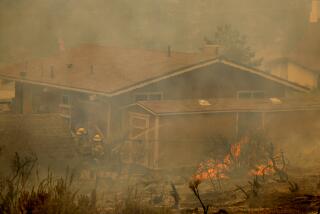Despite what Trump says, Finland fires are totally different from California fires
Reporting from PARADISE, Calif. — President Trump said California can learn from Finland on how to fight fires.
But the fires that burned Paradise and parts of Southern California are significantly different from the forest fires that hit Finland last year.
In an interview this week, Jonathan Pangburn, a fire behavior analyst for the California Department of Forestry and Fire Protection, said the Camp fire started in a rugged hillside area of the Plumas National Forest but quickly became an urban fire, burning blocks of homes in the town of Paradise at a time.
These are the victims of the California wildfires
“It started out as a vegetation fire. When it reached the incorporated area, which is definitely a lot more urban and developed of an area,” he said, “it turned into a building-to-building fire ... no longer carrying through most of the vegetation, especially in the upper canopies in the trees. It was not a crown fire through the Paradise area.”
As more structures caught fire, the situation just got worse.
“They put off so much heat, and so much debris in terms of burning embers that flow to other buildings, that it’s really a structure-to-structure ignition at that point. And that’s what we saw, unfortunately, in the Paradise area,” Pangburn said.
Indeed, in the aftermath, homes were burned out but many trees remained.
The Paradise fire has burned more than 10,000 structures and killed at least 71 people, with more than 1,000 still unaccounted for. It was fueled by intense winds gusting above 70 mph. The region has not had significant rainfall since May.
Trump has erroneously suggested that poor forest management is to blame for the destruction wrought by the Camp fire as well as the Woolsey fire, which burned through suburban Southern California from Oak Park to Malibu. More than 800 structures were lost and three people died.
The Woolsey fire was not near any forest.
On Saturday, Trump continued to talk about forest management, particularly forest floors.
“We’ve got to take care of the floors, you know, the floors of the forest. It’s very important,” the president said.
He said Finland focuses “on raking and cleaning and doing things, and they don’t have any problem, and when it is … I know everyone is looking at that.”
A heat wave this summer caused huge forest fires across Europe, including Finland.
Fires scorched forested areas in Lapland, a remote northern province near Finland’s border with Russia, forcing evacuations of summer cottages.
One big difference: Rainfall since May at Jarbo Gap in Butte County, near where the Camp fire started, was at 0.7 inches. The May-November rainfall in Rovaniemi, Lapland’s capital: 15.76 inches.
Finland and California also differ greatly in their winds, said meteorologist Geoff Fox in Irvine. California’s Santa Ana winds are dry, desiccating vegetation as they whip through canyons and passes. They don’t exist in Finland’s relatively flat country, Fox said.
Experts agree that overgrown forests in California pose a heightened wildfire threat in some parts of the Sierra Nevada.
But although Paradise is near forestland, the wind-whipped Camp fire tore across areas that burned in 2008 lightning fires and were also later logged. It is not fueled by heavy timber.
UPDATES:
6:10 p.m.: This article was updated with more information on differences in climate between California and Finland.
5:35 p.m.: This article was updated with more background information on the Camp fire.
This article was originally published at 5 p.m.
More to Read
Sign up for Essential California
The most important California stories and recommendations in your inbox every morning.
You may occasionally receive promotional content from the Los Angeles Times.












